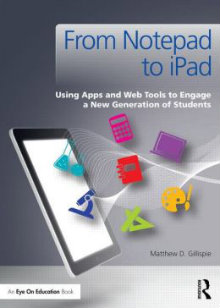From Notepad to iPad with Engaging Tools
From Notepad to iPad: Using Apps and Web Tools to Engage a New Generation of Students
By Matthew D. Gillispie
(Routledge/Eye on Education, 2014 – Learn more)

I’ve recently transferred to a school with a 1:1 iPad program, so I was very interested in what Matthew Gillispie had to share about his own experience. His book is a summary of a journey that started when he and three other teachers at his school received class sets of iPads through a grant.
Gillispie explains how he worked through his teaching and planning as he transitioned to using the iPads in his daily classroom teaching. At the end of the book he discusses how his school has changed as a result of the grant experiences, adopting 1:1 iPads schoolwide, highlighting the advantages and challenges this evolution will bring.

Tools for transformation
Subsequent chapters focus on how Gillispie updated his website and made his class more interactive using web based tools. He then discusses how he changed his teaching of the key components of high school Language Arts in a series of chapters. He addresses transforming writing, reading, communication and collaboration, and public speaking.
Gillispie also writes a chapter on assessment and data collection, and finishes the book with “Differentiating Instruction with iPads” and “Looking Forward.” Each chapter is sufficiently detailed so that the ideas and lessons could easily be used in your own secondary classroom. There are more lesson options and tools than can be used in a single year, but this allows teachers to have a lot of specific examples to choose from.
The appendixes of the book are also very helpful. The first is full of rubrics and assignment instruction sheets. The second is a list of tools that give a short but highly informative summary of each of the tools discussed in the book.
So many ways to learn in ELA and beyond
In the conclusion of the final chapter, Gillispie notes that “with the iPad students did much more than read and write in the classroom—they became readers, writers, authors of picture books, songwriters, talk show hosts, music video editors, advertisers, cartoon creators, poets, historians, filmmakers, comic creators, radio show hosts, news anchors, teachers, bloggers, and so much more.”
If we are to prepare students for the world after K-12 education, isn’t this really our goal, to teach them a variety of skills so they are able to be producers of information, not just consumers of the work of others?
This book contains many very excellent lessons and considerations for using iPads in the Language Arts classroom. If you are a middle or high school Language Arts teacher thinking of integrating iPads into your classroom, this book is a must-have.
If you teach subjects other than Language Arts, it is still a useful book as you can see many of the issues encountered when 1-1- iPads are introduced into the classroom and how to overcome them. You’ll also learn about many great apps and ways to incorporate them into your learning environment.
Laura Von Staden is a Special Education Middle School Teacher in Tampa, Florida. She serves on numerous committees both at her school and within her district and works closely with the local university where she is a Professional Practice Partner and a master mentor. Dr. Von Staden also facilitates both online and face-to-face Professional Development within her district.



































